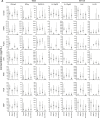Pattern recognition receptor-mediated cytokine response in infants across 4 continents
- PMID: 24290283
- PMCID: PMC3969582
- DOI: 10.1016/j.jaci.2013.09.038
Pattern recognition receptor-mediated cytokine response in infants across 4 continents
Abstract
Background: Susceptibility to infection as well as response to vaccination varies among populations. To date, the underlying mechanisms responsible for these clinical observations have not been fully delineated. Because innate immunity instructs adaptive immunity, we hypothesized that differences between populations in innate immune responses may represent a mechanistic link to variation in susceptibility to infection or response to vaccination.
Objective: Determine whether differences in innate immune responses exist among infants from different continents of the world.
Methods: We determined the innate cytokine response following pattern recognition receptor (PRR) stimulation of whole blood from 2-year-old infants across 4 continents (Africa, North America, South America, and Europe).
Results: We found that despite the many possible genetic and environmental exposure differences in infants across 4 continents, innate cytokine responses were similar for infants from North America, South America, and Europe. However, cells from South African infants secreted significantly lower levels of cytokines than did cells from infants from the 3 other sites, and did so following stimulation of extracellular and endosomal but not cytosolic PRRs.
Conclusions: Substantial differences in innate cytokine responses to PRR stimulation exist among different populations of infants that could not have been predicted. Delineating the underlying mechanism(s) for these differences will not only aid in improving vaccine-mediated protection but possibly also provide clues for the susceptibility to infection in different regions of the world.
Keywords: Innate immunity; global; immune development; infectious disease.
Copyright © 2013 The Authors. Published by Mosby, Inc. All rights reserved.
Figures






References
-
- Lewis D.B., Wilson C.B. Developmental immunology and role of host defenses in fetal and neonatal susceptibility to infection. In: Remington J.S., Wilson C.B., Baker C.J., editors. Infectious diseases of the fetus and newborn infant. 7th ed. Elsevier Saunders; Philiadelphia: 2011. pp. 80–191.
-
- Hostetter M.K. What we don’t see. N Engl J Med. 2012;366:1328–1334. - PubMed
-
- Black R.E., Morris S.S., Bryce J. Where and why are 10 million children dying every year? Lancet. 2003;361:2226–2234. - PubMed
Publication types
MeSH terms
Substances
Grants and funding
LinkOut - more resources
Full Text Sources
Other Literature Sources

